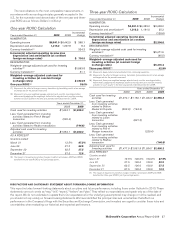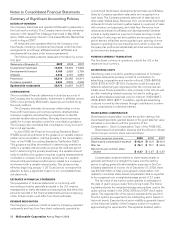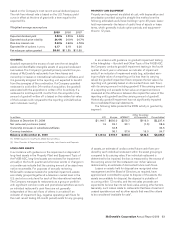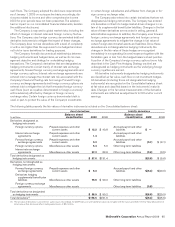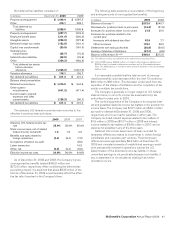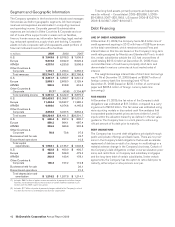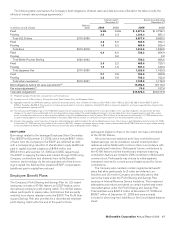McDonalds 2009 Annual Report Download - page 39
Download and view the complete annual report
Please find page 39 of the 2009 McDonalds annual report below. You can navigate through the pages in the report by either clicking on the pages listed below, or by using the keyword search tool below to find specific information within the annual report.currencies), the Company uses forward foreign currency
exchange agreements and foreign currency options to hedge a
portion of anticipated exposures.
When the U.S. dollar strengthens against foreign currencies,
the decline in present value of future foreign denominated royal-
ties is offset by gains in the fair value of the forward foreign
currency exchange agreements and/or foreign currency options.
Conversely, when the U.S. dollar weakens, the increase in the
present value of future foreign denominated royalties is offset by
losses in the fair value of the forward foreign currency exchange
agreements and/or foreign currency options.
Although the fair value changes in the foreign currency
options may fluctuate over the period of the contract, the
Company’s total loss on a foreign currency option is limited to the
upfront premium paid for the contract. However, the potential
gains on a foreign currency option are unlimited as the settle-
ment value of the contract is based upon the difference between
the exchange rate at inception of the contract and the spot
exchange rate at maturity. In limited situations, the Company uses
foreign currency option collars, which limit the potential gains and
lower the upfront premium paid, to protect against currency
movements.
The hedges typically cover the next 12-15 months for certain
exposures and are denominated in various currencies. As of
December 31, 2009, the Company had derivatives outstanding
with an equivalent notional amount of $608.4 million that were
used to hedge a portion of forecasted foreign currency denomi-
nated royalties.
The Company excludes the time value of foreign currency
options, as well as the discount or premium points on forward
foreign currency exchange agreements from its effectiveness
assessment on its cash flow hedges. As a result, changes in the
fair value of the derivatives due to these components, as well as
the ineffectiveness of the hedges, are recognized in earnings
currently. The effective portion of the gains or losses on the
derivatives is reported in the deferred hedging adjustment
component of accumulated other comprehensive income in
shareholders’ equity and reclassified into earnings in the same
period or periods in which the hedged transaction affects
earnings.
The Company recorded after-tax adjustments related to cash
flow hedges to the deferred hedging adjustment component of
accumulated other comprehensive income in shareholders’
equity. The Company recorded a net decrease of $31.5 million
for the year ended December 31, 2009 and net increases
of $47.3 million and $8.5 million for the years ended
December 31, 2008 and 2007, respectively. Based on
interest rates and foreign currency exchange rates at
December 31, 2009, no material amount of the $16.5 million in
cumulative deferred hedging gains at December 31, 2009, will
be recognized in earnings over the next 12 months as the under-
lying hedged transactions are realized.
• Hedge of net investment in foreign operations
strategy
The Company uses foreign currency denominated debt to hedge
its investments in certain foreign subsidiaries and affiliates. Real-
ized and unrealized translation adjustments from these hedges
are included in shareholders’ equity in the foreign currency trans-
lation component of accumulated other comprehensive income
and offset translation adjustments on the underlying net assets
of foreign subsidiaries and affiliates, which also are recorded in
accumulated other comprehensive income. As of
December 31, 2009, a total of $3.2 billion of the Company’s
outstanding foreign currency denominated debt was designated
to hedge investments in certain foreign subsidiaries and affiliates.
• Credit risk
The Company is exposed to credit-related losses in the event of
non-performance by the counterparties to its hedging instru-
ments. The counterparties to these agreements consist of a
diverse group of financial institutions. The Company continually
monitors its positions and the credit ratings of its counterparties
and adjusts positions as appropriate. The Company did not have
significant exposure to any individual counterparty at
December 31, 2009 and has master agreements that contain
netting arrangements. Some of these agreements also require
each party to post collateral if credit ratings fall below, or
aggregate exposures exceed, certain contractual limits. At
December 31, 2009, neither the Company nor its counterparties
were required to post collateral on any derivative position, other
than on hedges of certain of the Company’s supplemental benefit
plan liabilities where our counterparty was required to post
collateral on its liability positions.
INCOME TAX UNCERTAINTIES
In 2006, the FASB issued guidance on accounting for
uncertainty in income taxes, codified primarily in the Income
Taxes Topic of the FASB ASC.This guidance clarifies the
accounting for income taxes by prescribing the minimum recog-
nition threshold a tax position is required to meet before being
recognized in the financial statements. The guidance also covers
derecognition, measurement, classification, interest and penalties,
accounting in interim periods, disclosure and transition. The
Company adopted the guidance effective January 1, 2007, as
required. As a result of the implementation, the Company
recorded a $20.1 million cumulative adjustment to increase the
January 1, 2007 balance of retained earnings. The guidance
requires that a liability associated with an unrecognized tax bene-
fit be classified as a long-term liability except for the amount for
which cash payment is anticipated within one year. Upon adop-
tion of the guidance, $338.7 million of net tax liabilities were
reclassified from current to long-term.
The Company, like other multi-national companies, is regularly
audited by federal, state and foreign tax authorities, and tax
assessments may arise several years after tax returns have been
filed. Beginning in 2007, tax liabilities are recorded when, in
management’s judgment, a tax position does not meet the more
likely than not threshold for recognition as prescribed by the
guidance. For tax positions that meet the more likely than not
threshold, a tax liability may be recorded depending on manage-
ment’s assessment of how the tax position will ultimately be
settled.
The Company records interest on unrecognized tax benefits
in the provision for income taxes.
PER COMMON SHARE INFORMATION
Diluted net income per common share is calculated using net
income divided by diluted weighted-average shares. Diluted
weighted-average shares include weighted-average shares out-
standing plus the dilutive effect of share-based compensation
calculated using the treasury stock method, of (in millions of
McDonald’s Corporation Annual Report 2009 37


